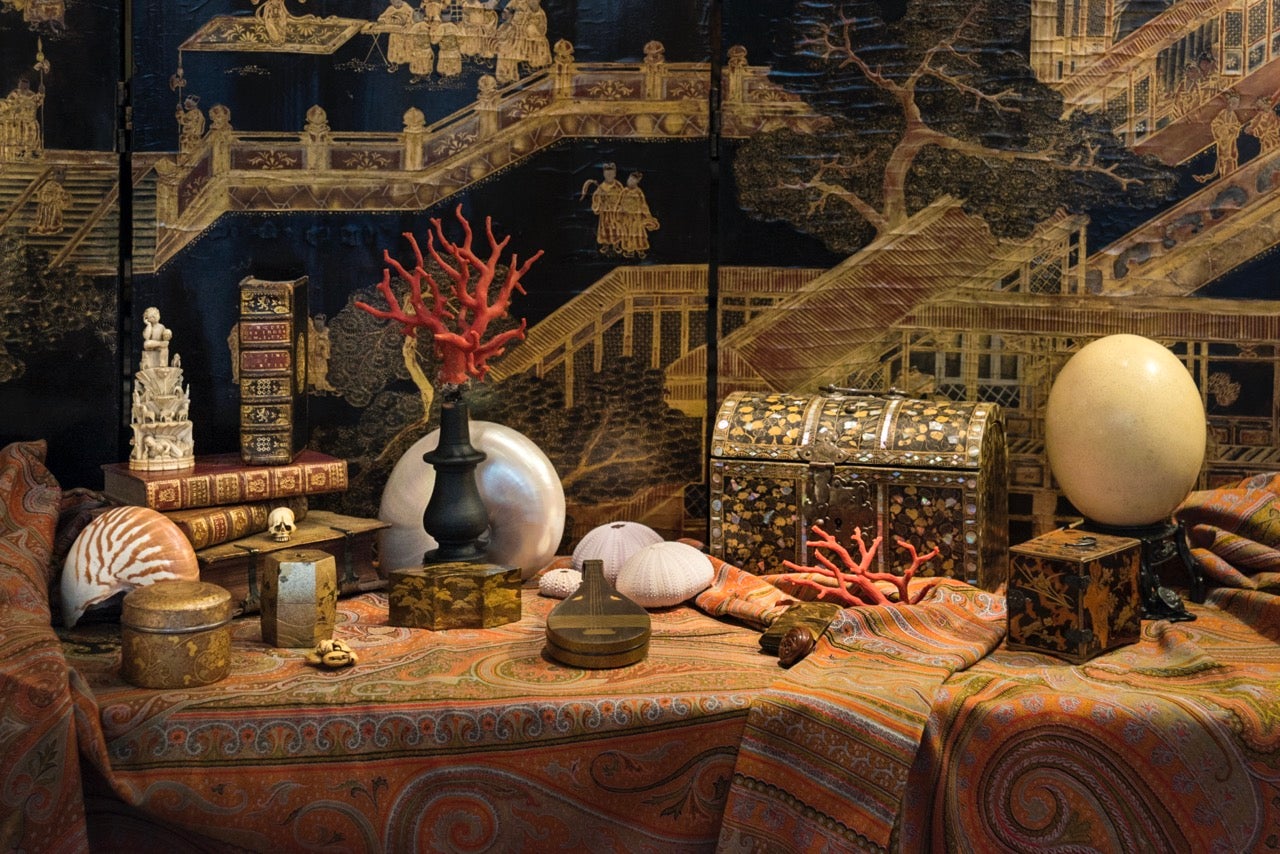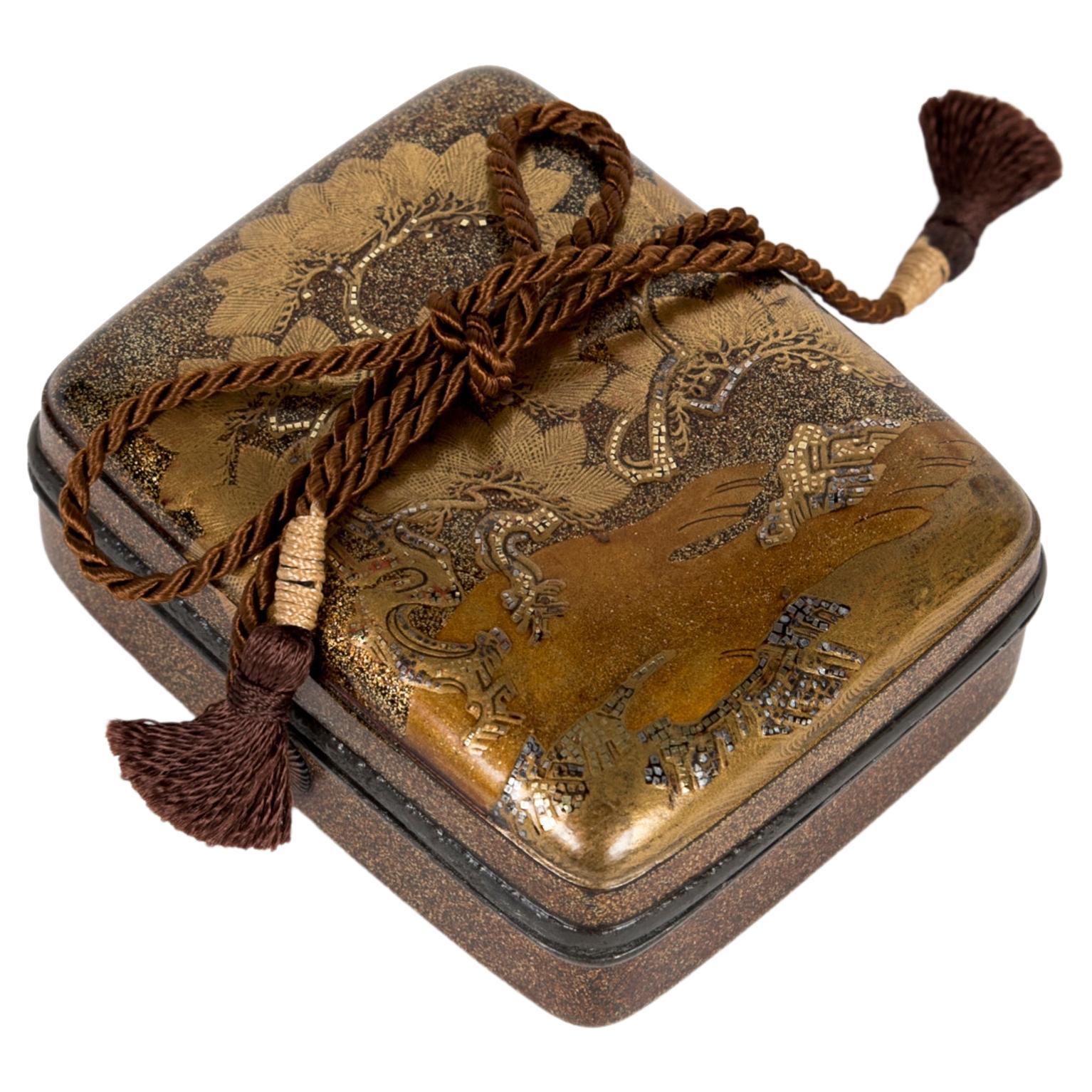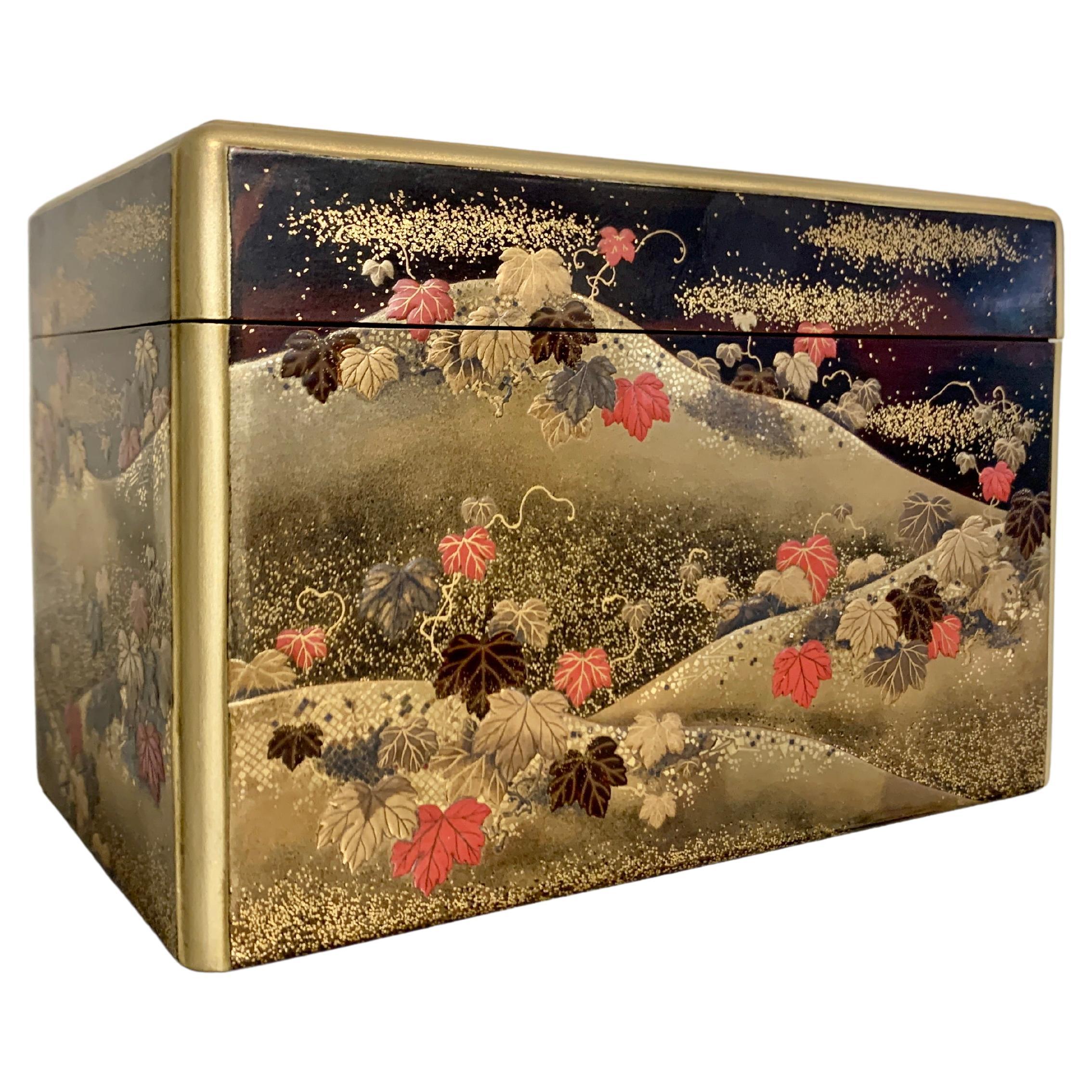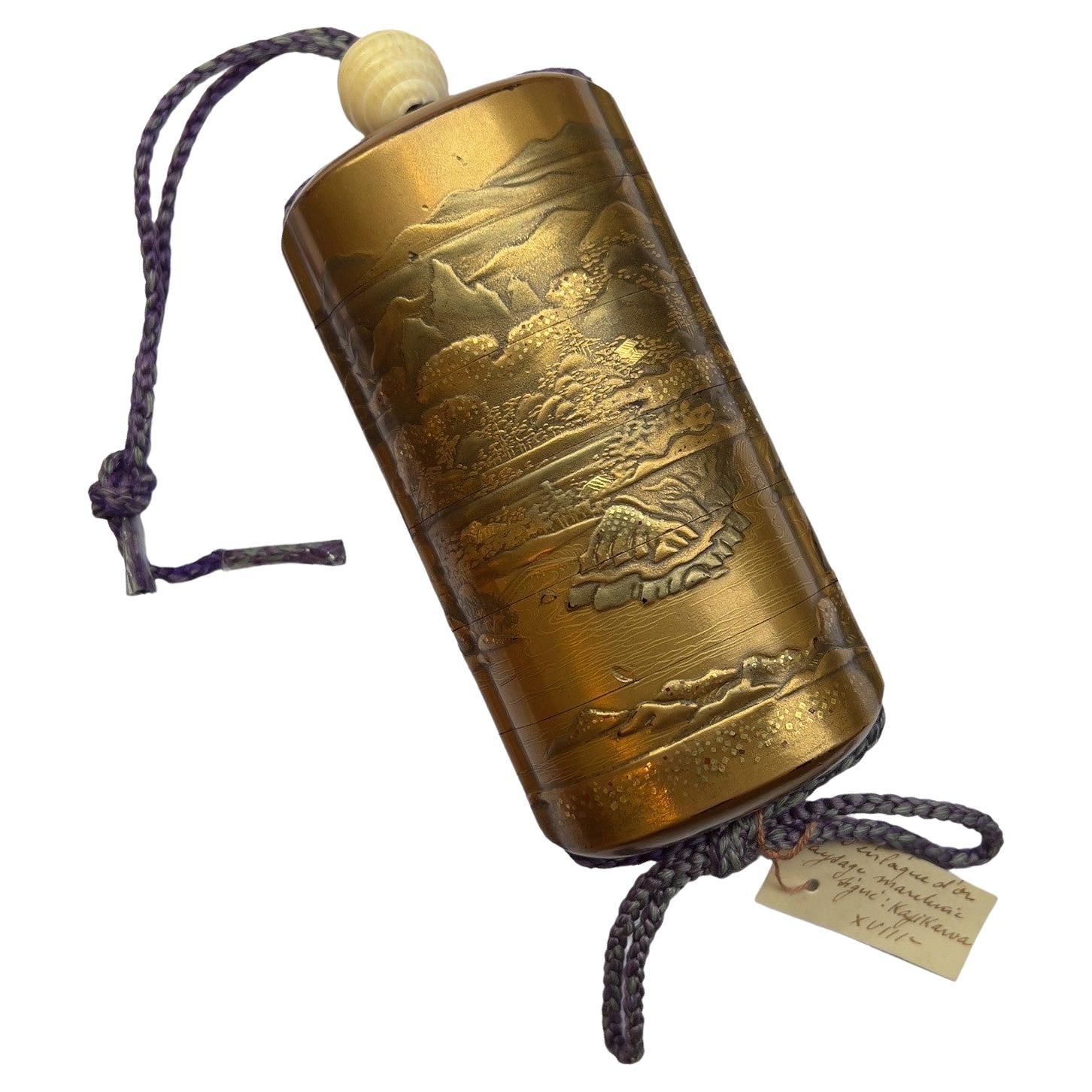Items Similar to Japanese golden kobako flowers Edo period 18th century
Want more images or videos?
Request additional images or videos from the seller
1 of 7
Japanese golden kobako flowers Edo period 18th century
About the Item
Quadrangular kobako box decorated with flowers in gold and blue lacquer with aogai inlay. Lid and sides in fundame lacquer, underside and interior in nashi-ji lacquer. Inside, a removable tray with gold fundame borders. Fitted with two gripping rings.
Provenance : Docteur Mène collection.
Doctor Édouard Mène (1833-18..?) was a doctor and vice-president of the Franco-Japanese Society. As great connoisseur of Japanese art, he began collecting Japanese objects such as armour and lacquerware in 1868 – when Japan opened up to the West. Following his death, his collection was sold at the Hôtel Drouot in April 1913 .
Three collection labels glued underneath, one bearing the inscription "Collection du Dr Mène", the others partially erased. Inside, glued label with the inscription "N°47".
Japan – Edo period (1603-1868), 18th century
Width: 2.4 in (6 cm) – depth: 2.4 in (6.3 cm) – height: 1.2 in (3 cm)
- Dimensions:Height: 0.79 in (2 cm)Width: 0.95 in (2.4 cm)Depth: 2.49 in (6.3 cm)
- Style:Japonisme (Of the Period)
- Materials and Techniques:
- Place of Origin:
- Period:
- Date of Manufacture:1700-1800
- Condition:Wear consistent with age and use.
- Seller Location:PARIS, FR
- Reference Number:

About the Seller
No Reviews Yet
Vetted Seller
These experienced sellers undergo a comprehensive evaluation by our team of in-house experts.
Established in 2013
1stDibs seller since 2023
- ShippingRetrieving quote...Ships From: PARIS, France
- Return PolicyA return for this item may be initiated within 7 days of delivery.
More From This SellerView All
- Japanese landscape pine kobako box Edo period 18th centuryLocated in PARIS, FRRectangular black and gold lacquer kobako box decorated with pine trees in a mountain landscape in takamaki-e, kirigane and hiramaki-e lacquer. Background in nashi-ji lacquer. Surmou...Category
Antique 18th Century Japanese Lacquer
MaterialsGold
- Japanese Lacquered Furoshiki Kobako 'Box'Located in PARIS, FRRectangular and flat lacquer Kobako (small box) representing a furoshiki knot seen from above. Fundame background, furoshiki in takamaki-e with floral pattern, inside the folds of the fabric with black and gold sayagata pattern with togidashi maki-e technique. The saya (or sayagata) pattern is composed of Chinese swastikas...Category
Antique Late 19th Century Japanese Lacquer
MaterialsLacquer
- Japanese black and gold foliage kobakoLocated in PARIS, FRKobako box decorated with stylized foliage in black and gold hiramaki-e lacquer. The motif is karakusa, a growing plant extending in all directions. It symbols prosperity and longevi...Category
Antique Late 19th Century Japanese Lacquer
MaterialsPewter, Gold
- Japanese peony basket lacquered box EdoLocated in PARIS, FREight-sided, flared shaped lacquer kobako box, following the decoration on the lid depicting a basket of flowers, composed of peonies and chrysanthemums in gold takamaki-e and hirama...Category
Antique 18th Century Japanese Edo Lacquer
MaterialsGold
- Japanese suzuribako lacquered box peony riverLocated in PARIS, FRSuzuribako box (empty) in black lacquer. Gold maki-e decoration of a river bordered by peonies, one with red highlights. The edges of the lid are in gold lacquer. Nashi-ji interior.Category
Antique Late 19th Century Japanese Lacquer
MaterialsGold
- Japanese Lacquered Tebako 'Box'Located in PARIS, FRTebako box with three compartments in golden and nashi-ji lacquer, decorated with golden, red, and kirigane lacquer, golden persimmon tree leaves, among rocks. The compartments are of increasing size from the top. The decoration is in continuity. Persimmon has been cultivated in southern China for more than 2500 years and is believed to have been introduced to Japan in the 8th century. The veneer is a tree with very hard wood, similar to ebony. According to a legend, one specimen survived the atomic bombing of Nagasaki on August 9, 1945, close to the epicenter. It is therefore in Japan a symbol of strength and longevity. It is also the national fruit of the country. It is eaten as a traditional dish during New Year's Day celebrations. Tebako literally means "portable box...Category
Antique 1860s Japanese Lacquer
MaterialsLacquer
You May Also Like
- Japanese Lacquer Box, Kobako, "The Ivy Way", Edo Period, 19th Century, JapanLocated in Austin, TXAn exquisite Japanese tall lacquer box for incense implements, kobako, with a scene from The Tales of Ise, chapter 9, "The Ivy Way Through Mt. Utsu", Edo ...Category
Antique Mid-19th Century Japanese Edo Lacquer
MaterialsLacquer
- Japanese Lacquer Writing Box, Suzuribako, Edo Period, 18th Century, JapanLocated in Austin, TXAn exceptionally fine and unusual Japanese lacquer writing implements box, suzuribako, in the form of a zither, koto, Edo Period, 18th century, Japan. With a modern wood storage box,...Category
Antique 18th Century Japanese Edo Lacquer
MaterialsGold, Silver, Copper
- Japan, Late 18th Century Gold Lacquer Inro by Kajikawa, Edo PeriodLocated in PARIS, FRLate 18th century Inro by Kajikawa. Edo period Beautiful inro in gold lacquer representing a continuous landscape on both sides. The interior in Nashiji lacquer. Some small traces...Category
Antique 18th Century Japanese Lacquer
MaterialsLacquer
- Japanese Samurai Abumi Stirrups Lacquer Edo, 18th CenturyLocated in Dallas, TXJapanese Samurai Abumi Stirrups lacquer Edo late 18th century, early 19th century. Measures: 12 inch length, 10 inch height, 5.5 inch width. AVANTIQUES is dedicated to providing an...Category
Antique Late 18th Century Japanese Edo Lacquer
MaterialsIron
- Japanese Inro by Koma Koryu Edo PeriodLocated in Atlanta, GAA four-case lacquered inro by Koma Koryu circa 19th century late Edo period. The inro features a pair of Chinese mandarin duck resting under a bundle of blooming irises on the pond. ...Category
Antique 19th Century Japanese Japonisme Lacquer
MaterialsWood, Lacquer
- Antique Japanese Inro by Shigehide Edo PeriodLocated in Atlanta, GAThis exquisite four-case lacquered inro was dated to the latter part of 18th century to early 19th century (Edo period) and made by Shigehide. The opposite sides of the inro together features a lavish flower arrangement in a bamboo basket (ikebana). The detailed craftmanship was a true pleasure to behold. Mostly Takamaki-e (high relief) were used to texturize the delicate petals of the chrysanthemums, on which different shades of gold were used to create contrast. Raden (mother of pearl) shells were also used to highlight some leaves, rendering the piece an interesting balance of color and material. The interior was completed in a mottled gold finish. It was signed Shigehide on the bottom with a Kao. There is a small carved rabbit ojime bead...Category
Antique Late 18th Century Japanese Japonisme Lacquer
MaterialsWood, Lacquer
Recently Viewed
View AllMore Ways To Browse
Southeast Asian Pearls
Art Deco Onlay
Takasago Couple
Lacca Giapponese
Negoro Nuri
Giant Silver Tray
Black And Gold Lacquer Chinese Miniature Chests
Japanese Lacquer Box Calligraphy
Japanese Lacquer Art
Mother Of Pearl Japan
Metal Netsuke
Japanese Meiji Period Silver Kodansu
Large Natural Shells
Steel Wall Lights Pair
Vintage Three Seat Sofas Seating
Solid Wood Display Cabinet
Apple Lighting
Mid Century Danish Dining Chairs Leather





